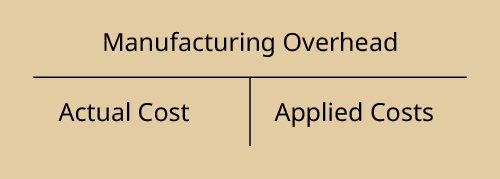8.2 Under- or Over-Applied Overhead
As you’ve learned, the actual overhead incurred during the year is rarely equal to the amount that was applied to the individual jobs. Thus, at year-end, the manufacturing overhead account often has a balance, indicating overhead was either overapplied or underapplied.
If, at the end of the term, there is a debit balance in manufacturing overhead, the overhead is considered underapplied overhead. A debit balance in manufacturing overhead shows either that not enough overhead was applied to the individual jobs or overhead was underapplied. If, at the end of the term, there is a credit balance in manufacturing overhead, more overhead was applied to jobs than was actually incurred. This shows the actual amount was overapplied overhead.
The actual overhead costs are recorded through a debit to manufacturing overhead. The same account is credited when overhead is applied to the individual jobs in production, as shown:

Since the overhead is first recorded in the manufacturing overhead account, then applied to the individual jobs, traced through finished goods inventory, and eventually transferred to cost of goods sold, the year-end balance is eliminated through an adjusting entry, offsetting the cost of goods sold. If manufacturing overhead has a debit balance, the overhead is underapplied, and the resulting amount in cost of goods sold is understated. The adjusting entry is:

If manufacturing overhead has a credit balance, the overhead is overapplied, and the resulting amount in cost of goods sold is overstated. The adjusting entry is:

Returning to our example, at the end of the year, Dinosaur Vinyl had actual overhead expenses of $256,500 and applied overhead expenses of $250,000, as shown:

Since manufacturing overhead has a debit balance, it is underapplied, as it has not been completely allocated. The adjusting journal entry is:

If the overhead was overapplied, and the actual overhead was $248,000 and the applied overhead was $250,000, the entry would be:

To adjust for overapplied or underapplied manufacturing overhead, some companies have a more complicated, three-part allocation to work in process, finished goods, and cost of goods sold. This method is typically used in the event of larger variances in their balances or in bigger companies. (You will learn more about this in future cost or advanced managerial accounting courses.)
YOUR TURN
Kraken Boardsports

Kraken Boardsports manufactures winches for snow and ski boarders to snow ski without a mountain or water ski without a lake (Figure 8.10). End-of-year data show these overhead expenses:

Kraken Boardsports had 6,240 direct labor hours for the year and assigns overhead to the various jobs at the rate of $33.50 per direct labor hour.
How much overhead was overapplied or underapplied during the year? What would be the journal entry to adjust manufacturing overhead?
Solution
The total overhead incurred is the total of:

The total overhead applied is $209,040, which is calculated as:
$33.50 ÷ direct labor hours × 6,240 direct labor hours.
The balance in manufacturing overhead is a debit balance of $210:

The adjusting journal entry is:


